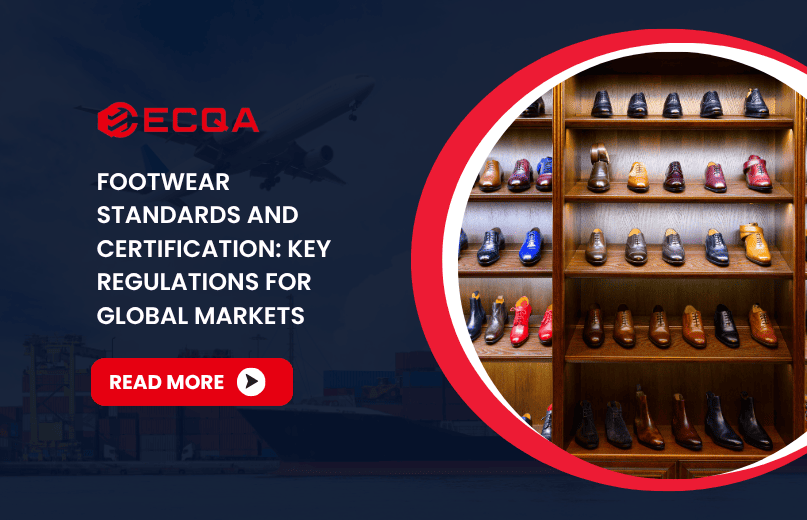
Footwear Standards:Key Regulations for Global Markets
Footwear standards define the required safety, quality, and performance levels that shoes and related products must meet before entering global markets. These footwear standards are developed and enforced by regional regulatory bodies to ensure the protection of consumers and the suitability of footwear for various environments and uses.

Compliance with applicable standards may include testing for slip resistance, chemical safety, structural strength, or material composition. Each region imposes its own requirements, and these must be observed precisely. Brands that operate internationally need to ensure that their products meet the correct footwear standards for each target market in order to achieve legal clearance, maintain consistency, and avoid costly setbacks.
Footwear Standards and Regulatory Bodies by Region
United States: ASTM and CPSIA Compliance
The U.S. market places strong emphasis on safety and consumer protection, with two major regulatory frameworks:
ASTM International (American Society for Testing and Materials)
ASTM F2413 is the definitive standard for protective footwear. It outlines strict criteria for:
- Impact resistance (e.g. toe caps must withstand 75 ft-lbs of impact)
- Compression resistance (2,500 pounds of pressure)
- Metatarsal protection
- Electrical hazard protection
- Puncture resistance
Products are labeled with the appropriate codes (e.g., “ASTM F2413-18 M I/75 C/75 EH”) indicating exactly which protections the footwear provides.
CPSIA (Consumer Product Safety Improvement Act)
This applies especially to children’s footwear. Manufacturers must ensure products are free from:
- Lead in paint and substrates
- Phthalates (restricted to 0.1% in accessible parts)
- Sharp points or small parts that could cause choking
Third-party testing and tracking labels are mandatory. All children’s shoes must have traceable information including production date and batch.
European Union: CE Marking and EN ISO Standards
In the EU, footwear must comply with Regulation (EU) 2016/425 on personal protective equipment (PPE) and other sector-specific laws depending on use.
EN ISO 20345, 20346, and 20347
These standards govern the performance of safety, protective, and occupational footwear.
- EN ISO 20345: Safety footwear with toe protection (200 Joules impact)
- EN ISO 20346: Protective footwear (100 Joules impact)
- EN ISO 20347: Occupational footwear (no toe cap but other safety features)
All compliant footwear must bear the CE mark, backed by:
- Lab test reports
- Declarations of conformity
- Technical documentation
Depending on risk category, third-party notified bodies may need to verify test results.
China: GB Standards for Domestic and Imported Footwear
China has its own mandatory and recommended footwear standards under the GB (Guobiao) system.
Key examples include:
- GB/T 15107-2013: Leather shoes
- GB/T 25036-2021: Children’s shoes (replaces GB 25036-2010)
- GB/T 43293-2022: Footwear size designation (replaces GB/T 3293.1-1998)
- GB 30585-2014: Safety requirements for children’s footwear
Chinese authorities may also require:
- CCC (China Compulsory Certification) for specific categories
- Full test reports from CNAS-accredited labs
- Chinese-language labeling with production and importer information
Failure to comply may lead to customs rejection or enforcement action.
United Kingdom: UKCA Marking
Following Brexit, the UK introduced the UKCA (UK Conformity Assessed) marking to replace CE for products sold in England, Wales, and Scotland.
Footwear must comply with:
- BS EN ISO standards (aligned with EU versions)
- UK-specific guidance issued by the Office for Product Safety and Standards (OPSS)
UKCA markings follow similar rules to CE but must be issued under UK-based conformity assessment bodies.
Canada: CSA Group Certification
The Canadian Standards Association (CSA) sets high expectations, especially for occupational and safety footwear.
Footwear Standards like CSA Z195 specify:
- Toe and sole protection
- Electrical shock resistance
- Chainsaw cut protection
- Sole puncture resistance
Footwear must display certification markings on the tongue or tag, with corresponding icons (e.g., green triangle, yellow triangle, white rectangle).
Footwear standards define the technical and regulatory framework that governs market access across regions. From the United States and the European Union to China, the United Kingdom, and Canada, each jurisdiction sets specific performance and safety requirements that must be addressed at the design and production stages.
Effective compliance management ensures that each product is tested, documented, and properly labeled according to its destination market’s regulations. Companies that establish clear procedures for meeting applicable standards reduce risk, avoid disruption, and support long-term brand credibility. Learn more about how to pass quality checks for retail-ready footwear.

 Request Free Sample Report
Request Free Sample Report